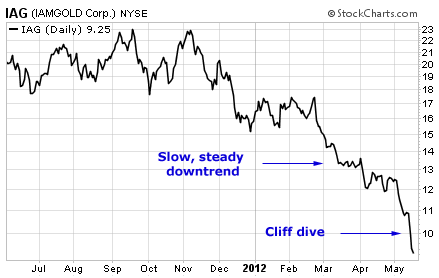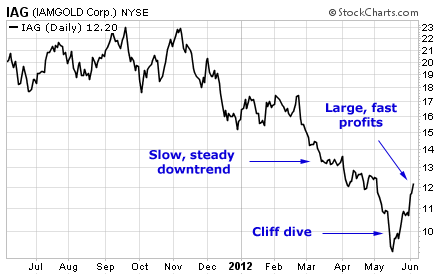 Easy trades – trades you feel good about… ones that are comfortable to make… ones you talk about at cocktail parties and everyone agrees – usually turn out to be losers.
Easy trades – trades you feel good about… ones that are comfortable to make… ones you talk about at cocktail parties and everyone agrees – usually turn out to be losers.
It’s the tough trades that can make you a fortune. Trades that turn your stomach… ones you have to hold your nose to buy… where you feel suicidal to even attempt – those are the ones that make money…
[ad#Google Adsense 336×280-IA]In my experience, the toughest trade to make is to sell short into a parabolic move higher.
But it has almost always been profitable.
I say “almost always” because, while I’m sure it hasn’t worked out at some point over my 30-year career, I honestly can’t remember when it didn’t make money.
Consider the parabolic move in silver back in April 2011.
Or the move in gold last August.
Selling short into both of those moves was emotionally tough to do. It’s always tough to go against a popular trend… But it would have been tremendously profitable.
Sadly, the market is a little light on parabolic moves right now. Government bonds are getting close. But it still feels a bit too comfortable to make that trade… which means government bonds probably still have higher to go.
So I’m falling back on the second-toughest trade… buying into cliff-diving declines.
A cliff dive is the opposite of a parabolic move. Rather than rocketing higher in an unsustainable spike to the upside, a stock falls off a cliff.
Take gold producer Iamgold (IAG), for example. Here’s how the chart looked just before I recommended it in my Advanced Income newsletter two weeks ago…
 A cliff dive typically occurs at the end of a slow, steady downtrend. It’s a selling capitulation where the last diehards holding onto the stock finally throw in the towel.
A cliff dive typically occurs at the end of a slow, steady downtrend. It’s a selling capitulation where the last diehards holding onto the stock finally throw in the towel.
And here’s how the stock looks today…
 Of course, it’s foolish to go out and try to buy every cliff-diving stock. Sometimes there’s a valid reason for the drop – like a bankruptcy filing or the discovery of fraud. You have to look for stocks where the fundamentals are solid – so you can be sure the cliff dive is an emotional overreaction and not a justified decline.
Of course, it’s foolish to go out and try to buy every cliff-diving stock. Sometimes there’s a valid reason for the drop – like a bankruptcy filing or the discovery of fraud. You have to look for stocks where the fundamentals are solid – so you can be sure the cliff dive is an emotional overreaction and not a justified decline.
In the case of IAG, at $10 per share, the stock traded at just five times earnings. The company had no debt and held $2.83 per share in cash on its balance sheet. Shares were beaten up with the rest of the gold sector. So it was an ideal candidate to buy… and the jump off the cliff gave us a great entry price.
Now that the stock market has given up all its gains for the year, this is the type of chart that offers the best trade setup on the long side. It may be tough to buy a stock after it’s fallen off a cliff. But it often generates large, fast profits.
But be sure to use trailing stops to limit your downside risk on these sorts of trades.
Best regards and good trading,
Jeff Clark
P.S. My Advanced Income subscribers are already showing 12% gains from the Iamgold “cliff-diving” trade I recommended just two weeks ago. I have another trade lined up and ready to go for next week as well. To learn more about subscribing to Advanced Income in time for my next trade, click here.
Source: The Growth Stock Wire
